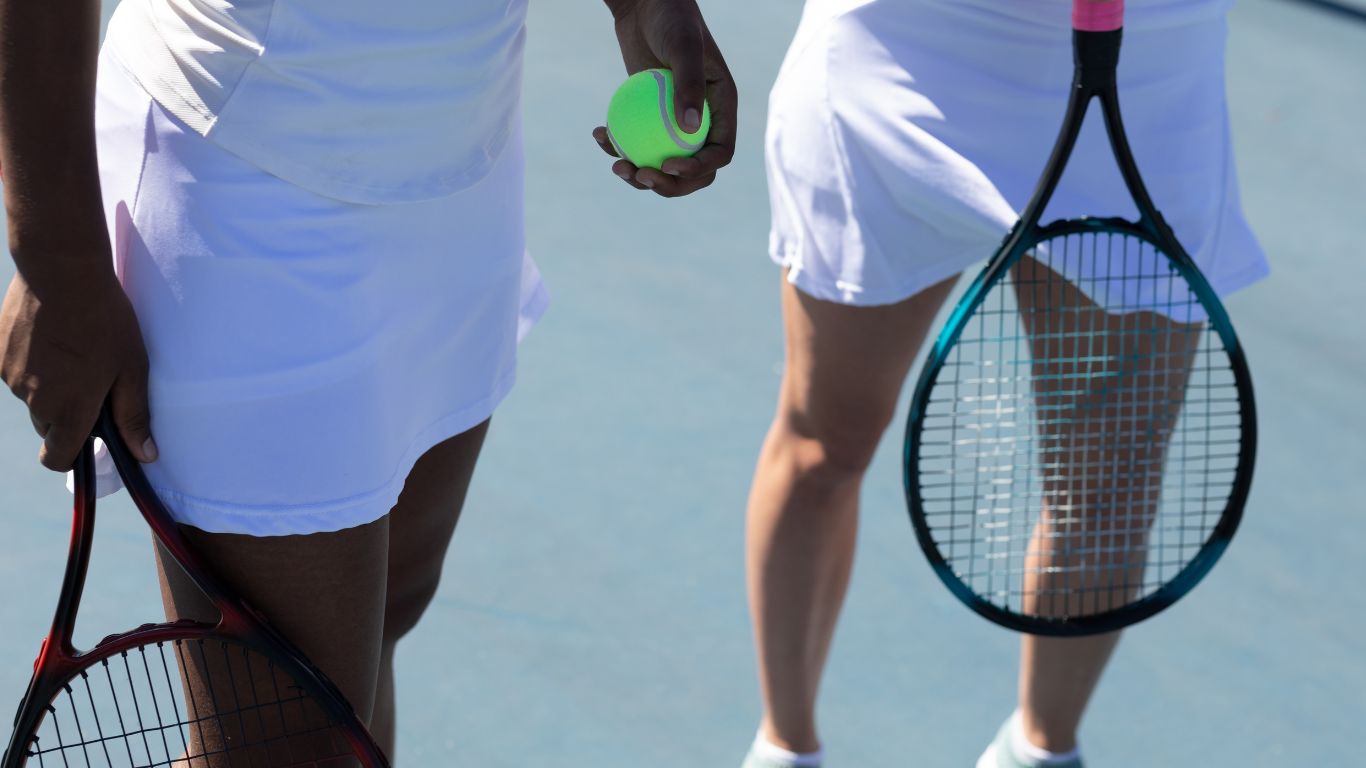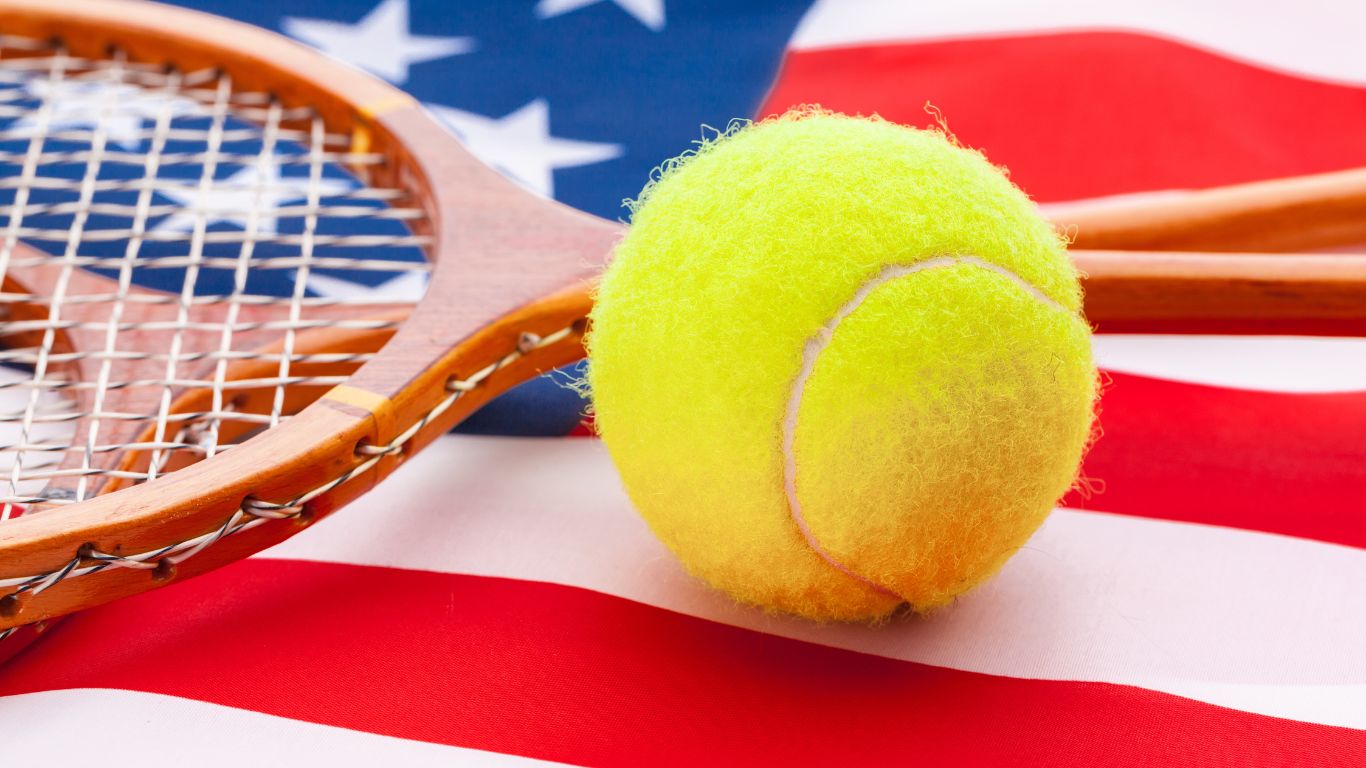To play tennis, you need a racket, a ball, and access to a tennis court. Players score points by hitting the ball over the net into the opponent’s court without the opponent returning it.
Tennis is a fast-paced racquet sport that can be played individually against a single opponent or between two teams of two players each, known as doubles. It is a globally popular sport that involves skill, strategy, and physical endurance. Whether you’re a beginner or looking to refine your game, understanding the basic rules and techniques of tennis is essential.
Players aim to serve the ball effectively, maintain volleys, and outmaneuver opponents to win games, sets, and ultimately the match. With consistent practice and a good understanding of the game’s fundamentals, anyone can enjoy the competitive and rewarding nature of tennis.

Credit: www.wikihow.com
Gearing Up For The Game
Before stepping onto the tennis court, the right gear is crucial for both comfort and performance. From choosing your racket to donning the appropriate attire, preparing to play tennis involves several key steps. Let’s explore the essentials for gearing up.
Choosing The Right Equipment
Finding a tennis racket that suits your style of play is fundamental. A good grip size and the right head balance can make all the difference. With an array of strings available, opt for ones that offer the best feel for your swings. Tennis balls come in various types, so select ones approved by the USTA or ITF for official matches.
| Racket Type | Feature | Benefit |
|---|---|---|
| Lightweight | Easy handling | Better control |
| Heavyweight | More power | Greater ball speed |
| Wide Body | Larger sweet spot | Forgiving on off-center hits |
Dressing For Success On The Court
Comfortable, breathable clothing is a must. Lightweight fabrics help you stay cool while you play. Shoes designed for tennis provide the support and grip required for quick lateral movements. It’s essential to wear proper athletic socks to prevent blisters.
- Shirts: Moisture-wicking material
- Shorts/Skirts: Flexible and with pockets for balls
- Shoes: Non-marking soles with good cushioning
- Accessories: Wristbands, headbands, and caps for sweat management
All set with the right equipment and attire, you’re ready to hit the court.
Understanding The Court Layout And Scoring System
Tennis is a thrilling game that engages your body and mind. Before you serve and rally, it’s vital to grasp the basics. A clear understanding of the court layout and scoring system forms the foundation of this dynamic sport. Let’s dive into these essentials and get you ready to play!
Deconstructing The Tennis Court
A standard tennis court is rectangle-shaped with specific dimensions. The court is 78 feet long and 27 feet wide for singles matches. For doubles, the court widens to 36 feet. A net divides the court into two equal sides.
Baselines mark the court’s length, while the sides are defined by sidelines. The ‘alley’ is the extra space on each side for doubles play.
The service boxes are the areas where serves must land. Service lines and center marks help guide your serve position. Familiarity with these lines and boxes is key to strategic play.
| Part of Court | Description |
|---|---|
| Baseline | End lines where you serve from |
| Sidelines | Mark singles and doubles boundaries |
| Service Boxes | Target for serves |
| Net | Divides court into two halves |
Decoding The Scoring Methodology
In tennis, scores can seem puzzling at first glance. Points progress from love (zero) to 15, 30, then 40. Scoring a point post-40 leads to a game win unless both players reach 40, known as ‘deuce.’
From deuce, a player must gain a two-point advantage to win a game. This means winning one point gets you to ‘advantage,’ but the game isn’t over until a two-point lead is achieved.
Winning six games by at least two clears the path to a set victory. Usually, matches are best-of-three or best-of-five sets. Grasping these numbers is essential for strategic play and ultimate success.
- Love: Zero points
- 15, 30, 40: First three points
- Deuce: Tie at 40
- Advantage: Point after deuce
Remember, the scoring system in tennis rewards consistency and endurance. It’s not just about the big shots; it’s about playing the long game. The joy of tennis amps up as you master the rhythm of scoring.
Essential Tennis Strokes To Kickstart Your Game
Embarking on your tennis journey starts with mastering the basic strokes. Every tennis player, from beginners to pros, relies on these fundamental shots. With practice, you can transform these strokes into powerful tools on the court. Let’s dive into the essential techniques that will set the foundation for your tennis game.
Forehand And Backhand Techniques
Forehand strokes are a vital part of your tennis arsenal. Stand with your feet shoulder-width apart. Grip your racket comfortably. Swing with a fluid motion, transferring your weight from the back foot to the front. Keep your eye on the ball and follow through.
Backhand strokes can be one-handed or two-handed. The key to a solid backhand is balance and footwork. Align your body sideways to the net. Step into the shot with your leading foot. Swing the racket across your body and stay focused on the ball.
- Forehand tip: Lead with the racket back early and snap the wrist upon impact.
- Backhand tip: Use your non-dominant hand to stabilize the racket, especially for two-handed backhands.
Perfecting The Serve
The serve initiates play and can be a powerful weapon. Start with your feet parallel to the baseline. Toss the ball high enough that you can hit it at its highest point. Snap your wrist as you make contact. This will give you more power and control.
| Step | Action |
|---|---|
| 1 | Stand correctly with feet shoulder-width. |
| 2 | Toss the ball consistently. |
| 3 | Hit the ball with a fluid motion. |
Practice different serve types like flat, slice, and kick serves. This will make you unpredictable and challenge your opponent.
Mastering The Volley
Volleys require quick reflexes and sharp technique. Stand near the net with your knees slightly bent. Keep your racket in front of you. As the ball comes, step forward and punch the ball softly over the net. The key is minimal backswing and a firm wrist.
- Use a continental grip for better wrist flexibility.
- Stay on your toes and be ready to move quickly.
- Focus on placing your shots rather than power.
Concentrate on consistently hitting the sweet spot of your racket. This will give you the control needed to place your volleys accurately.

Credit: www.wikihow.com
Footwork And Body Positioning
Mastering tennis starts with the basics, like footwork and body positioning. Good footwork helps players reach the ball and prepare for shots. Proper body positioning allows for balance and control, making every shot more effective. Let’s explore how to enhance these skills.
Coordination Drills For Improved Movement
To move quickly and effectively, tennis players need coordination. Drills that improve movement can help with this.
- Ladder drills: They boost agility and speed.
- Cone drills: Players weave through cones, improving coordination.
- Shadowing: Copying another player’s moves sharpens reflexes.
Strategic Court Positioning
Knowing where to stand on court can lead to winning points. Position impacts your ability to make shots and defend.
| Position | Advantage |
|---|---|
| Baseline | Power shots and defense |
| Mid-court | Volley and attack |
| Net | Quick points and smashes |
Rules And Etiquettes Of The Game
Tennis, a sport enjoyed worldwide, blends intense action with strict guidelines. To ensure a fair and enjoyable match, players must grasp the in-game rules and uphold the highest sportsmanship standards. This section details these crucial concepts, guiding you from a foundation in the rules to the subtleties of proper tennis etiquette.
Familiarizing With In-game Rules
The rules of tennis have key points everyone should learn:
- A match consists of sets, and sets break down into games.
- To win a set, a player must win at least six games by a margin of two.
- Serving is always diagonal, from the baseline into the opposite service box.
- The ball can hit any part of the line for the point to be good.
- A tiebreak is played when the score reaches 6-6 in games.
| Score | Description |
|---|---|
| 0 Points | Love |
| 1 Point | 15 |
| 2 Points | 30 |
| 3 Points | 40 |
| Deuce | When both players reach 40 |
Conduct And Sportsmanship
Upholding sportsmanship is as vital as mastering strokes:
- Respect your opponent and officials.
- Avoid causing delays. Play promptly.
- Shake hands at the end of the match.
- Courteous language is mandatory.
- Admissions of faults or touches are a sign of integrity.
Whether it’s calling your own shots out or acknowledging a great play by your opponent, these practices ensure the game remains respectable and pleasurable for all involved.

Credit: www.youtube.com
Practice Makes Perfect
Tennis requires not only talent but also dedicated practice to master the game. Skill refinement is a journey of constant repetition and commitment. To excel in tennis, players must embrace the mantra ‘Practice Makes Perfect.’
Drills And Exercises For Regular Practice
Regular drills and exercises are key to a tennis player’s growth. These routines help sharpen techniques and enhance agility on the court.
- Forehand Drills: Focus on power and precision with repetitive strokes.
- Backhand Drills: Improve consistency on both single and double-handed backhands.
- Serving Practice: Target various box areas to refine serve accuracy.
- Footwork Exercises: Use agility ladders to boost quickness and court movement.
- Volley Drills: Sharpen net play with rapid volley exchanges.
Engaging In Match Play For Experience
Match play offers invaluable experience. It tests skills under pressure and teaches strategy in real-time.
- Challenge Peers: Regular games with peers push competitive boundaries.
- Join Leagues: Participate in local leagues for diverse play styles.
- Enter Tournaments: Test skills in a structured, high-stakes environment.
- Analyze Matches: Reflect on game footage to identify areas for improvement.
Frequently Asked Questions On How To Play Tennis?
How Do You Play Basic Tennis?
Start by serving the ball from behind the baseline into the opposite service box. Return the ball before the second bounce once it’s on your side. Aim to send the ball back over the net within the court boundaries. Score points by playing until the ball goes out or isn’t returned.
Keep rallying until a player wins four points and leads by at least two.
How Can I Teach Myself Tennis?
Start by learning basic tennis rules and grips through online tutorials. Practice essential strokes—forehand, backhand, serve, and volley—against a wall or with a ball machine. Watch professional matches for technique insights. Gradually play with partners at your level to improve your game.
What Is Tennis And Its Rules?
Tennis is a sport where players hit a ball over a net using rackets. Each match consists of sets and games; the first to win six games wins a set. Players must win by two points in a game and at least two games more than their opponent in a set.
How Would You Play Tennis?
To play tennis, equip yourself with a racket and tennis balls. Start by learning forehand and backhand strokes. Practice serving accurately and develop your footwork. Play on a proper court, following the rules, and score points by hitting the ball over the net within bounds.
Conclusion
Embarking on your tennis journey can be exhilarating and rewarding. With consistent practice and dedication, you’ll see noticeable improvements in your game. Remember to enjoy each match and celebrate your progress. Grab your racket, hit the court, and let the fun begin.
Serve up your best – you’ve got this!









